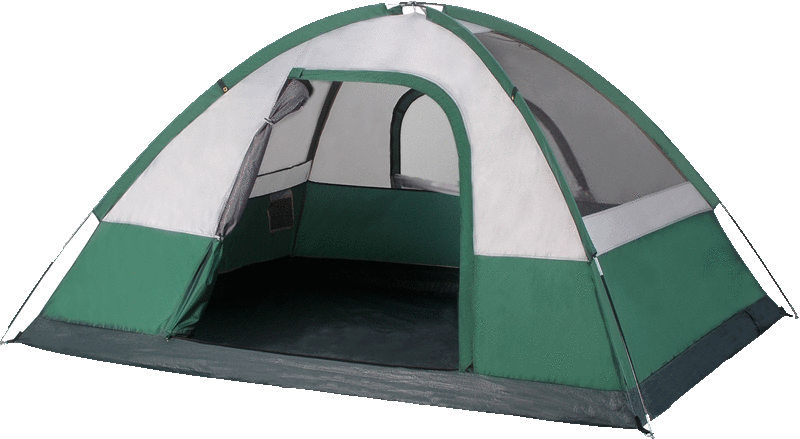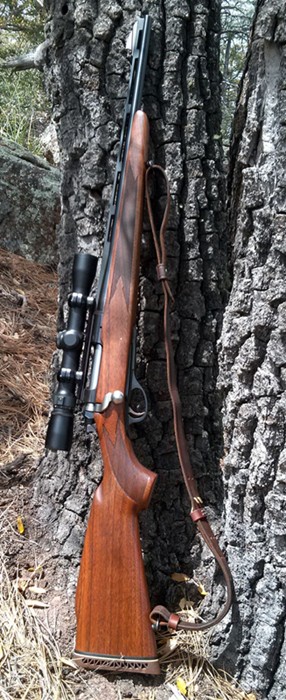How many of you have ever thought about, or actually tried your hand at
leather work? Making your own rifle sling has got to be one of the easiest
ways to get started with leathercraft.
This is a new hobby that I’ve been dabbling in lately. It kind of started
when I decided to make my own shirt pocket eyeglass case. I had been using
the cheap vinyl ones for a number of years. Over time, they start breaking
down on the top edge, getting ratty and ugly. One day, I just got fed up
with my latest broken-down vinyl case and decided that I was going to make
my own out of leather.
So I hopped down to Tandy Leather at 35th Avenue and Greenway Road and bought
a suitable sized piece of leather and a sewing awl. This is a super simple
project. Using the old vinyl case as a pattern, I cut out the leather, folded
it over, and sewed down one side and across the bottom. Voila! One nice
leather eyeglass pouch that will last for a very long time! The leather took
on a beautiful medium brown hue after rubbing in a generous amount of leather
oil.
I wrote last month about acquiring a second Remington Model 600. My first
M600, the 6mm, came with a Hunter brand commercial copy of the M1907 military
type leather sling. It may be the only sling the rifle has ever known. I
never used it how a military sling is supposed to be used. Only recently have
I done some research to learn exactly how to use a military sling to steady
your shots. On the 6mm, I simply adjusted it once to a length of my liking,
and locked the length by lacing in a piece of leather bootlace through some of
the holes. I used it purely as a carrying strap, and was happy as a clam.
When the .308 Model 600 came home, it did not have any sling swivels, so
therefore it had no sling. Since I was happy with the look of a classic
leather sling on the 6mm, that’s also what I wanted on the .308.
Alright, maybe I was not TOTALLY happy with the sling on the 6mm. Since I had
tied it into a fixed length for carrying over my shoulder, when I wasn’t
carrying the rifle, the sling would hang off the rifle in a big loop. I wished
that there was a way that I could adjust the sling to a shorter storage length
for when I put it into a rifle case, for example.
For those of you who understand the proper configuration and use of the M1907
rifle sling, you know that shortening it so that it runs in a tight line from
the front sling mount to the rear is easy. But again, I had never figured that
out, and I had laced it into a fixed length anyway.
If you don’t understand the proper configuration and use of the M1907 military
rifle sling, don’t feel bad. It’s kind of complicated.
The M1907 style is a two-piece sling. When it is pulled tight into the storage
position, there are as many as four layers of sling lying on top of each other!
That’s a lot of leather.
The M1907 is popular with high power rifle competitors because it can be
configured to create a bicep loop that cinches down tightly on your upper arm.
This bicep loop helps to pull the butt of the rifle tightly into your shoulder
and helps aid stability in the prone, kneeling, and sitting positions.
You can go ahead and call me stupid if you want, but for a hunting rifle, all
I really want is a carrying strap. I’m not interested in monkeying around with
my sling to tighten it around my bicep to get into a textbook shooting position
when the moment of truth pops up

The classic Model 1907 military rifle sling on a M1 Garand
|
Still, the M1907 has a very classic “old school” look to it with the brass (or steel)
“frogs” and the many holes all up and down the sling. The rows of holes allow you to
adjust the sling length by moving and inserting the frog’s “feet” into the various hole
pairs up and down the length of the sling.
My interest in foreign military surplus rifles had acquainted me with the much less
complicated sling for the Swiss K-31 straight-pull bolt action carbine. The Swiss do
not use the sling as a shooting aid. It is simply used as a carrying strap. What I
like about that sling is the way it can easily be pulled into a straight and tight
storage position lying next to the stock, but then it can also be quickly pulled open
into the long strap-over-the-shoulder mode. It accomplishes this with a keeper loop
that is attached to one tail of the leather strap near the front sling mount.
So I got the idea to make a hybrid of these two slings. The fore-end side of the sling
would use the Swiss K-31 system, while the buttstock end would use the U.S. M1907 system
to allow adjustment of the overall sling length.
Since I was having fun with leathercraft, my plan was to build such a sling from scratch.
Tandy Leather has various sized belt blanks which would make a great foundation. They
even have the frogs. But to attach the frogs, I would need rivets and the necessary
rivet-setting tools. To make holes for the rivets, plus all the holes for the frog’s feet,
I would need a leather hole punch.
To make the sling look a little more interesting than just a flat strap, I also picked up
a tool called a stitching groover. This tool can be adjusted to create a shallow groove
at some fixed distance that you set, from the edge of the strap. One other tool that I
picked up was an edge beveler, which slices off a very thin strip from the 90° edge of the
strap to give it a more finished look.
So upon coming home from the leather store and spreading out all my newly purchased
treasures in front of me on the coffee table, I started thinking about how to get started.
I realized that I would need some sling swivels.
|
Right: Scratch-built hybrid sling on the left, modified commercial sling on the right
|
I have accumulated a pile of old rifle slings over the years. I used most of them for
one or two seasons, then decided that I didn’t like them after all for whatever reason.
Most of these slings had sling swivels attached to them.
So I raided the collection of old slings for the purpose of scavenging all the sling
swivels that I could. But in my raiding I came across another commercial M1907 style
sling that I had picked up a few years ago, but had never used on any rifle.
I figured that this would be a good model for the hole locations and spacing at least,
so I grabbed it to take to my leather working table.
But then a funny thing happened. As I was taking the sling apart and separating it into
its constituent components, I realized that the long strap of the sling was at least 90%
of the way toward what I was trying to create with the hybrid sling design. It would be
a lot easier just to modify this sling, than it would be to build one up from scratch.
In fact, the only thing that I would need to do would be to install the fixed keeper band
at the end of the long strap opposite to the frog.
With the hole punch, I punched two new holes toward the tail end of the sling. I used one
of the keeper loops supplied with the sling, which I riveted in place using the riveting
tools. Voila again! I now had one very cool Swiss K-31/U.S. M1907 hybrid sling. Below
is how it works:
Pulled tight into the storage configuration:

Opened up into the hunter carrying configuration: A simple, clean, single strap.
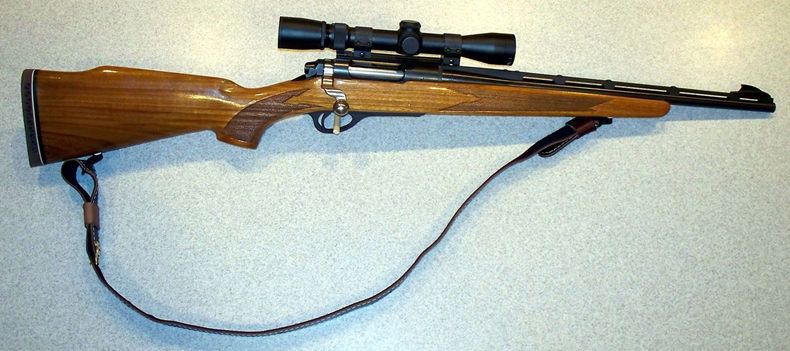
|
With my hybrid design, you end up discarding the short strap of the M1907 sling, thereby
reducing weight and complexity – always a good thing. One of the negatives of the standard
M1907 configuration from the hunter carry perspective is that the smooth side of the leather
is against your shoulder. But to prevent slipping off the shoulder while walking in the
field, it is better to have the rough side of the leather against your shoulder. This new
design accomplishes that goal.
Inspired by the Swiss K-31 sling, the forward end has a
fixed keeper riveted to the front tail of the sling. By pulling down on the tail tab, the
sling is tightened from the carrying configuration into the storage configuration.
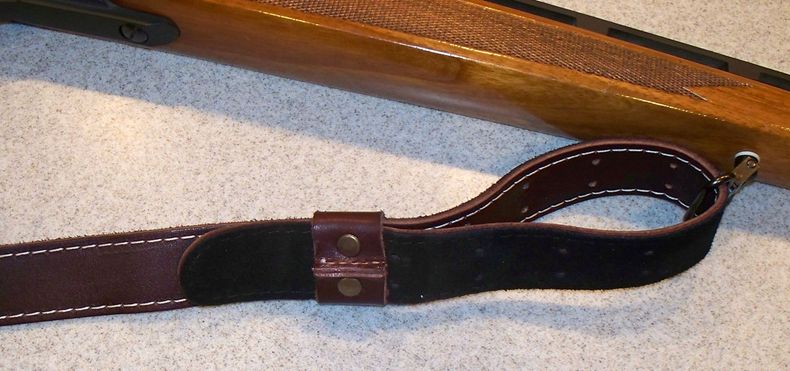
Detail of the buttstock end. This is the U.S. M1907 inspired part of the sling, with brass
frog. This first prototype started as a M1907 style sling, so there is a series of frog holes
up and down the length of the sling. This allows overall sling length adjustment to fit rifle
and shooter. Also shown is a hand-sewn keeper loop.
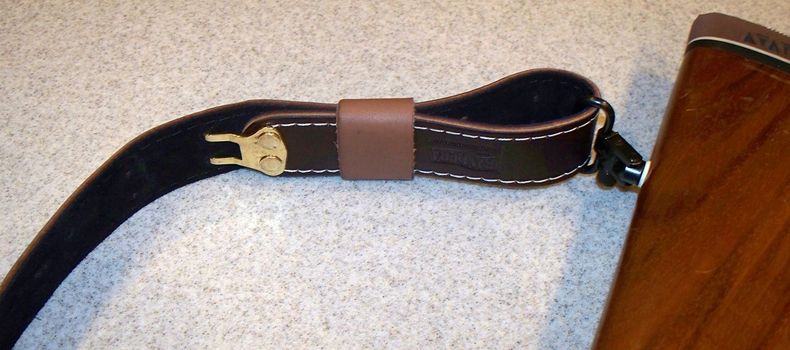
|
So with the rapid prototype executed and the concept proven, it was time to turn to
duplicating this design from scratch. Using the finished hybrid sling as a template, I
copied the length (44”), the hole locations, and the placement of the fixed keeper. I
created the decorative groove around the entire edge of the sling which sort of simulates
the line of stitching on the commercial sling. Riveting the frog in place was simple and
easy using the hole punch and the rivet setting tool. I used a piece of 1” steel strap as
a backer when setting the rivets. Perhaps the hardest part was sewing up my own keepers.
A liberal application of neatsfoot oil finishes the sling.
The commercial sling that I started with is a
Bandera brand, available at
Sportsman’s Warehouse for under $35. It is 1¼” wide. To make the scratch-built sling, I used a 1¼” wide veg-tanned belt
blank. I think the one I used was 50 inches long to start, which I trimmed down to 44”.
The Hunter brand sling on my 6mm is a 1” wide sling. Although I prefer the 1¼” width, I
converted the 6mm’s Hunter brand sling into my hybrid sling design. Since the rifle
appears to have been mated with this sling for many years, I saw no need to break up the
happy relationship.
After finishing two scratch-built slings of my hybrid design, I’m not sure it was worth it.
While definitely fun and satisfying to roll my own, I think that I am happier with how the
modified Bandera sling came out. Plus, the Bandera sling comes with two sling swivels. By
the time you add the cost of two sling swivels purchased separately to the cost of the
components of the scratch-built sling, you are approaching the cost of the modified commercial
sling. The feeling of accomplishment of making your own is wonderful, but if functionality
is the driver, then it is easier to start with a store-bought sling and modify it.
I’ve really been thrilled with how this sling project has turned out. It seems to be a
genuinely useful new sling design for the hunter that I’ve seen nowhere else.
For old school rifle marksmen, it is still capable of use
as a loop sling. Just disconnect the buttstock quick-release sling swivel, move the frog up
toward the fore-end attachment, and you have a bicep loop with sliding keeper. Also shown in
this photo is the discarded lower sling piece from the original M1907 sling configuration.
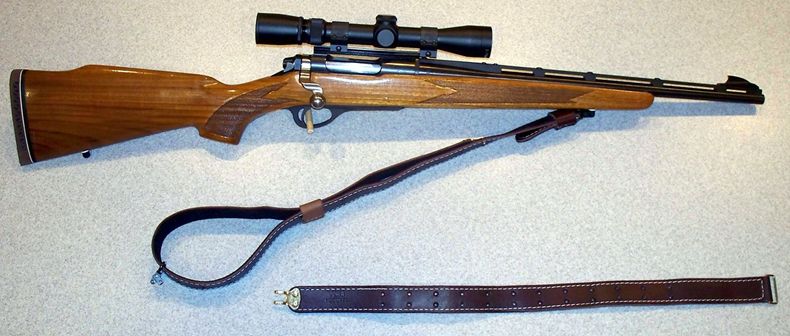
Photo from last month’s story: Unexpectedly, I discovered
another way to use this sling design for shooting stability. By sliding your hand into the
front loop that is formed when the sling is pulled into the storage configuration, you can
use the edge of your hand against the riveted keeper to pull the rifle back into your shoulder.
Despite how it may look in the photo, the grip of the support hand on the fore-end is relaxed.
This allows the arm and shoulder muscles to do most of the work. The front loop can be quickly
adjusted to vary the position of your hand on the fore-end for personal preference. When
rearward pressure is thus applied, there is no slippage of the front loop.
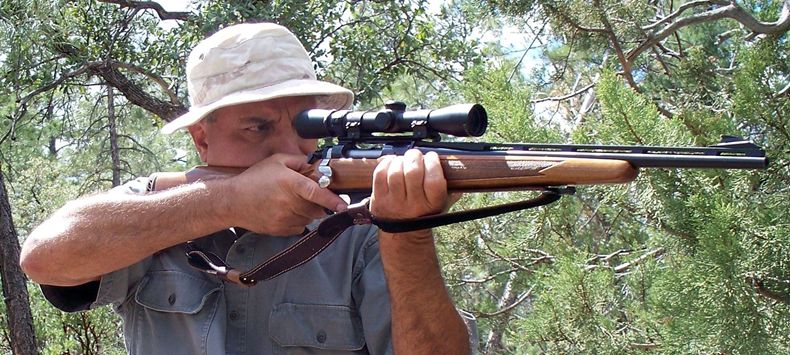
|

![]()
